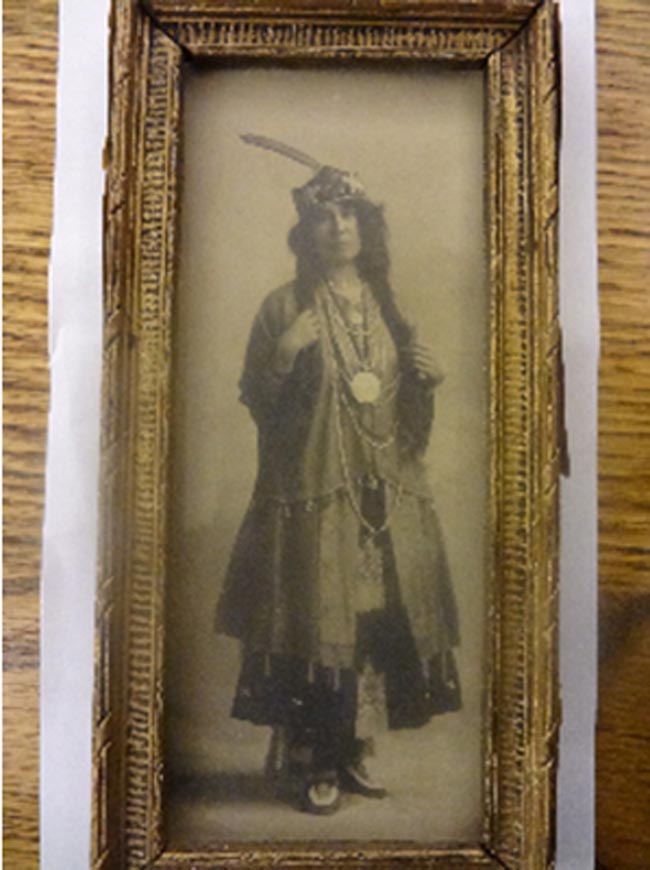Wawanosh descendant real Indian princess

By Laurie Leclair
The undated sepia photograph rests in its original gold frame as part of the Wawanosh Family Papers at Western University in London, Ontario.
Agnes Sands, the daughter of Julia Wawanosh Sands and the granddaughter of Chief David Wawanosh, Chippewas of Sarnia, poses in traditional clothing: exquisitely-beaded leggings and blouse, moccasins and flowered cap. She’s tiny, only 5’3” and dark; her wavy black hair reaches past her waist.
Agnes had prepared for a lavish party held at the stately home of her Christina Street neighbours, the Lawrences, oil and timber merchants who kept homes in both Sarnia and Toronto. Her escort for the night, a music professor named Frederick Hopson, came to the fancy-dress party as a naval officer.
We are not sure when the event occurred. Agnes’ beautiful face is timeless — as is her dress — so it is difficult to date the photograph, which could have been taken anytime before 1912 when the Lawrence family moved for a time to Toronto. Agnes was happy, and remembering the party decades later wrote, “Oh! What fun!” As a final coup, Agnes was crowned “Princess of the Evening”, her enigmatic image captured by a photographer who attended the gathering.
Agnes’ few words serve as a Belle Époque time capsule, a memory of those peaceful, prosperous and fleeting years before the Great War. By 1917 this fragile photograph would rest in the duffle bag of a sailor named Jack on board a United States submarine and headed for European waters.
Jack’s full name was Joseph Phillips Mern, a steamfitter from Brooklyn and six years Agnes’ junior. The couple probably met when Jack worked in Sarnia from 1915 to 1916. When the US decided to enter the war, Jack enlisted in the navy. It is tempting to think that Agnes’ image gave the sailor some comfort, especially after he was wounded when his submarine, the USS 0-3 was mistaken for a German U-boat and attacked by friendly fire in 1918. He received a citation for his bravery but the incident left him permanently disabled.
Jack and Agnes’ romance was also a casualty of the war. Census records show Jack living in New York and Agnes remaining at the family home in Sarnia for several years after the Armistice. On July 6, 1928 Jack returned to Sarnia, this time as a divorced father with a six-year-old son. The couple were reunited, and perhaps the sepia photograph returned. During this time they married and Agnes moved to New York, playing a very active role in an organization called The American Indians of Brooklyn.
The family lived in Marcy, Oneida County, New York until Jack’s early death at the age of 47 in 1940. By the end of the decade Agnes was back home and remained there until her death in 1966.
Not only did Agnes live her life in two countries, but also in two worlds. Indian Department records reveal that she underwent the process of enfranchisement in 1910. When she crossed over to Michigan in 1914 to work as a seamstress she identified as French and stated that her father was Thomas Waldie.
In spite of this, and the fact that she lived for the better part of her life off- reserve in the city of Sarnia, she, like her mother before her, kept the surname Wawanosh. An article from the Brooklyn Daily Eagle for March 19, 1934 remarked, “Mrs. Mern has in her possession a silver medal presented to her grandfather by the Prince of Wales, later King Edward VII, when he visited this country….”
Agnes was rightfully proud of her grandfather, David Wawanosh who represented the Chippewas of Sarnia during the 1860 royal visit. David voiced his concerns over land claims, defalcations and fishing rights to the prince in the hope of restitution.
Agnes chose to represent her heritage through a very public presence at parades and commemorations in Oneida County, NY. The fact that she returned home after Jack’s death speaks to her need to be by her community and family, whether re-installed in her Christina Street home or on the reserve – now known as Aamjiwnaang First Nation — where her mother Julia had maintained a small farm.
She may have regained an interest in her culture during those years in America, but judging from the large round medal she is wearing in the Lawrence portrait, it is probable that that pride in her Anishinabek heritage had been there all along.
Laurie Leclair is a principal of Leclair Historical Research and a treaty researcher for the Union of Ontario Indians.

